For the first time since April 2020, Aotearoa is back in a Level 4 lockdown following the discovery of a case of the Delta variant of Covid-19 in the community. The lockdown will initially go for 7 days in Auckland and the Coromandel, and 3 days in the rest of the country. However, it seems likely that at least Auckland may remain in some form of lockdown for longer.
We hope you’re all doing well, and that you’re safe and sound in your bubbles!
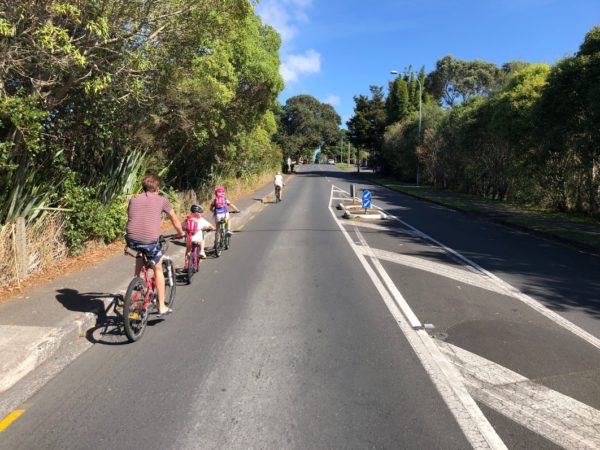
Last year, we saw cities around the world respond to the pandemic by transforming their streets to allow safe social distancing. Working from home, needing to distance from our neighbours, and fewer cars travelling on the streets posed lots of new questions and ideas about how we can make our cities and streets work better for us. I remember hearing about the planned emergency works, and feeling excited about the transformational potential. It looked like Auckland could be following in the footsteps of cities around the world that were reclaiming streets for people in response to the pandemic.
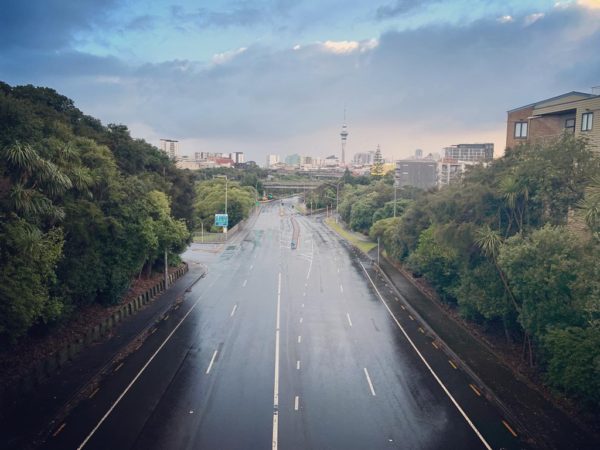
I thought it would be interesting to revisit posts Greater Auckland published last year on the Covid-19 pandemic now that we are here again. Can Auckland look forward to tactical changes for safe social distancing – as cities around the world are doing?
April 7, 2020: Innovating Streets
Matt reported on Waka Kotahi’s announcement of their Innovating Streets programme of financial, organisational and technical support for tactical urbanism projects:
We like that they’ve been so explicit in the types of projects that will be supported and that this fund can’t be used for expanding car capacity. It leaves things in no doubt what the purpose of this is and again it’s great it’s coming through from the NZTA. We’re also thrilled to see Low Traffic Neighbourhoods are listed, as they are the most comprehensive way to calm traffic…
Importantly, this better use of public space doesn’t need to be temporary. As the economy picks up again, we can accommodate the increasing number of trips by using space-efficient public transport and cycling.

April 20, 2020: The Great Upskilling
Heidi proposed a ‘Great Upskilling’ of Auckland Transport in both tactical urbanism and the tools needed to deliver Healthy Streets. After several weeks of nearly car-free streets, we were thinking about what life would be like when traffic returned to the streets while we shifted up the levels.
Auckland will face some new transport challenges during Alert Levels 2 and 3. The space required for physical distancing when walking and cycling will conflict with higher traffic volumes when more people start driving. Cities overseas have shown how to respond to these sorts of conditions, including Bogota way back in mid March…
After decades of community disempowerment, it’s taken a pandemic to reignite hope that we can create healthy streets. If Auckland Transport’s internal barricades to progress can be removed through a great upskilling in response to the emergency, Auckland’s future will look far rosier.

April 28, 2020: AT steps up to deliver COVID emergency works
This hopeful post from Matt towards the end of our first Level 4 lockdown celebrated AT’s announcement of Covid-19 emergency works. The plan included 17km of temporary bike lanes, and proposed closing the lower section of Queen Street to cars.
Normally quiet neighbourhoods are bustling with people walking and cycling. Even many normally busy arterials have until now been so quiet that families feel comfortable enough riding on them with their children. It has shown there is a huge latent demand for better walking and cycling facilities…
As well the need to provide more safe space all the people walking and cycling, many places have been seeing more people on bikes than in cars, we should also be looking at how we can lock in some of changes.
Matt also cautioned:
What isn’t quite clear at this stage is what happens when COVID restrictions are lifted. Are AT going to suddenly rip out all these new temporary improvements and put an end to the bike boom, is parking cars along the waterfront going to be considered more valuable than safety?
June 4, 2020: What longer-term transport impacts might Covid-19 have?
This post looked at how Covid-19 has impacted our travel patterns, from public transport use to walking and cycling, and made some predictions about how things might continue to be different in the future. It’s pretty interesting to look back on some of those thoughts now that we’ve had more than a year of mostly-normal-life, interrupted with a few shorter lockdowns.
In June last year, public transport ridership was still around 50% of its pre-Covid average. GA predicted that ridership would return to normal, but slowly. Fear that ongoing low numbers would result in budget cuts that would lead to a PT services ‘death spiral’ fortunately negated. Our most recent ridership figures are purple in the graph below:
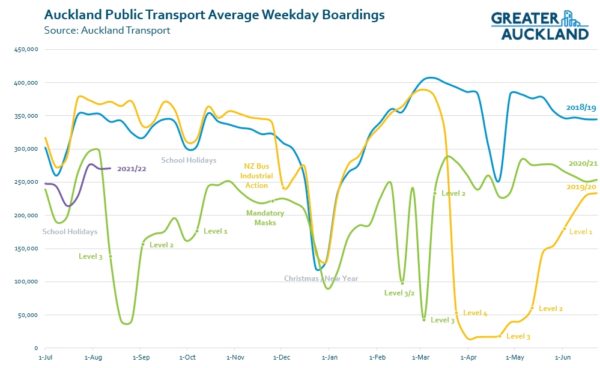
But this post also noted the lost opportunity in the evaporation of measures to support other modes. AT’s emergency works in April and May had disappeared by June, along with the temporary protected cycleways.
It has been a little bit heartbreaking to see that disappear in recent weeks, especially as Auckland Transport have been incredibly half-hearted in their efforts to create safe space for people walking and cycling…
Unfortunately [we] will likely look back on the recovery from COVID-19 as a missed opportunity to make a step-change improvement to walking and cycling in Auckland. The proposed budget cuts for safety and cycling projects will also likely mean more vulnerable users of our streets unnecessarily die or are seriously injured.
July 1, 2020: The Power of Disruption
In July, Heidi wrote about the opportunity inherent in disruption. This remains the fundamental opportunity of Covid-19, which is a disruption that’s not going away any time soon. The ideas explained in this post are as relevant now as they were a year ago.
When disruptions result in permanent behaviour change, they are a type of discontinuity. Since we’ve left our response to climate change too late, discontinuities are our best hope for achieving the radical change the IPCC says we need to achieve.
Covid has enabled a discontinuity. Cities are moving to permanent changes in their streets, their speed limits, their planning processes, and their transport budgets. As a result, residents will enjoy healthier, lower-carbon, more pleasant, and more active lifestyles.
The realisation that lower-carbon living is possible and brings an improvement in lifestyle is critically important – it brings citizens hope that democracy will willingly respond to climate change. Fuelled by hope, voters are far more likely to agree to other proposed climate action.
Heidi also linked the excellent work done by Dr. Kirsty Wild and Eloise Gibson:
In Tāmaki Makaurau, the experiences of lockdown were beautifully captured by Dr Kirsty Wild of Women in Urbanism, in her research, Life in a Low Traffic Neighbourhood, and powerfully illustrated by Eloise Gibson in Life in Light Traffic.
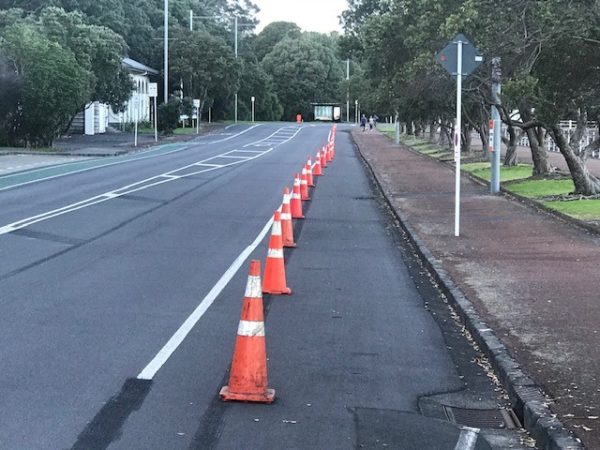
July 8, 2020: COVID-19 AND AN RTN(-LITE)
This was a guest post by Roger Wilson, suggesting that Covid-19 could be an opportunity to bring forward a number of already-planned enhancements to the rapid transport network. He proposed this could be achieved by starting with a ‘lite’ version of many of the routes now, rather than waiting until their programmed full implementation date.
All these routes could be designated “strategic” lines by a combination of (a) making them limited stop (the Airport-Manukau link will be and much of the 110 already is) and (b) implementing 24/7 bus lanes and signal pre-emption/priority… I don’t want to wait a decade for something gold-plated… with a minor reallocation of resources this could be Auckland’s strategic network next year:
September 7, 2020: The missing COVID-19 transformation
This post from last September was written as Auckland came out of its second lockdown, the August Covid-19 cluster that put the city into Level 3 for several weeks. By this time, the pop-up cycleways of the first lockdown were a distant memory, and they did not return. The Queen Street works were still in place, but only because of the efforts of city councillors who stopped them from getting removed at the request of a few disgruntled retailers.
The post quotes at length from a deeply critical piece by Hayden Donnell on The Spinoff. A response from Councillor Pippa Coom pointed out some wins (and these did look like wins at the time.) Here’s a random selection:
2. The emergency measures rolled out during the first lockdown provided the catalyst for the Innovating Streets project Ponsonby Road Te Rimu Tahi “returning P’rd to the people”. It’s now funded and has full support of the business association (win)
This project appears to have been shelved.
5. In addition to the new fast track applications for outside dining licences, AT is working on a process for businesses to be able to make use of on-street car parking spaces for parklets
Can anyone point to any hospitality parklets?
7. The Cornwall Park Trust Board moved quickly to open up roads to walking & cycling but the same approach hasn’t happened in council managed parks. Auckland Domain would be a good place to start
Now also seems like a good time.
Overall the transformation is work in progress and I’m hopeful the opportunities aren’t going to be squandered but Auckland sure does need to get a wiggle on. Thanks @HaydenDonnell for going on your search
Are we wiggling yet?
Your turn now, Auckland Transport.
AT’s Covid-19 Update emails so far have just mentioned avoiding travel unless it is essential, and details about public transport.
As our Prime Minister has made clear, this outbreak was always a matter of “when” not “if” so we should expect AT to have an emergency plan that will provide the social distancing needed to keep everyone safe.
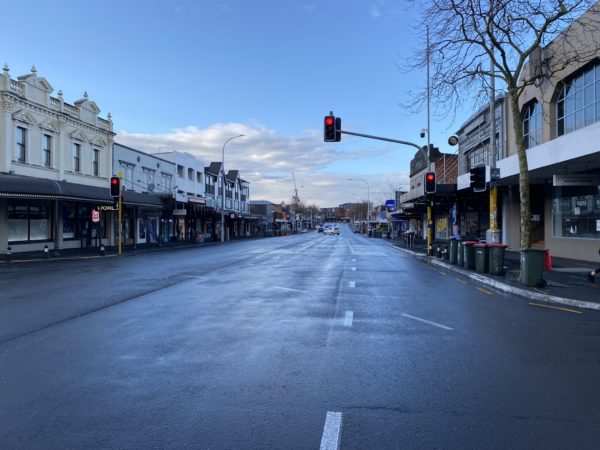
So what does your dream post-Covid-19 emergency street look like?
For the next week (or more), I’m going to get to enjoy cycling without having to battle the usual seven lanes of cars. Just turning right out of my street is going to feel a lot safer. I’ll be grinning through my mask at families and kids I see out and about making the most of the quiet streets, and hoping all drivers will go slowly for them.
My dream permanent street improvement as a Covid-19 legacy looks like a non-stop protected cycleway along Meola Road, West End Road, Jervois Road and Ponsonby Road, all the way to Karangahape Road. What’s yours?
Ponsonby level 4 at rush hour pic.twitter.com/yljBIaXyt5
— Fiona Miles (@fionam_miles) August 17, 2021


 Processing...
Processing...
Thanks for collecting those Marita. Disappointing to say the least how little has been done since then – Ponsonby Road being one glaring example.
The inaction on Ponsonby Road is a disgrace. The funding is there. The design is done and submitted on. And now, crickets from AT.
A walk along it today shows the same as Fiona’s pictures in the post. Almost no traffic. Rough estimate as I walked was that bikes equalled motor vehicles on the road and pedestrians were 3-4 times the number of cars and to distance from each other on the footpath tended to walk on the road a bit. Yet none of the road has been sectioned off for pedestrian and cycle safety.
An easy and immediate change for the Level 4 and inevitable subsequent Level 3 should be to make all P Rd parking pedestrian space, doubling what’s available on the footpath. There is a huge amount of unused parking on the side streets which can meet the need of any parking requirement on P Rd. Then take the inside vehicle lane and make it a separated cycle lane. Encourage safe cycling.
The one remaining lane in each direction for vehicle traffic is more than enough for the minimal traffic needs right now.
Come on AT – get on to it.
Any way we can see the design?
https://at.govt.nz/projects-roadworks/ponsonby-road-streets-for-people/
Timeline on the project page says “Early – mid 2021 – Detailed design, temporary changes installed, street activations and monitoring.”
Reporting in from the burbs, and a local early morning walk. People are out walking, jogging, biking, scooting; kids on bikes and scooters getting their wiggles out before online school; and all the dogs are grinning from ear to ear.
There’s a whole lot of instinctive road reallocation going on – people are using the road to give each other the advised 2m clearance, and walking around parked cars rather than scuttle to the edges of the footpath.
What traffic there is, is going at *at least* 50kmh. This is not a safe situation. We really don’t need anyone heading to hospital just because they were trying to get some simple exercise while following the rules to keep their neighbours safe. An emergency lowering of the speed limit on city streets to the survivable limit of 30kmh would be a useful start.
As per Waka Kotahi’s Covid-19-specific guidance on setting speed limits (from 28 April 2020):
https://www.nzta.govt.nz/assets/About-us/COVID-19-emergency-speed-limit-guidance.pdf
—
“Setting emergency speed limits is an effective and immediate control that road controlling authorities can implement to mitigate the possibility and outcome of traffic crashes in this COVID-19 period.
Setting emergency speed limits is permitted in the Land Transport Rule: Setting of Speed Limits (2017), with the criteria and process outlined in Section 7.
Covid-19 has been accepted as an “epidemic”, meeting the Clause 7.1 (1) criteria for considering an emergency speed limit.
An emergency speed limit may apply while the emergency conditions exist and for a maximum of 12 months.
[…]
Urban Environments: Consider setting of 30km/h emergency speed limits in urban environments, particularly to support Covid-19 alert levels that require social distancing between active road users, resulting in use of the road space.”
—
Fortunately, local road-controlling authorities do not need the approval of any other organisation to do this. (E.g. last year, AT instituted temporary 30kmh zones alongside some of its pop-up safety measures, but they vanished with the works: https://at.govt.nz/media/1982761/22-april-board-mtg-consideration-of-emergency-speed-limits-for-covid-19.pdf)
Unfortunately, setting emergency speeds requires signage – which may be challenging to organise at Level 4, and is all the more reason to wish (or hope?) that some preparatory work had been done on this while we enjoyed the breathing room of the last year and a half.
I have one dream for friends of mine who need it: popup cyclelanes on Great South Rd around Manukau – Papatoetoe – Otahuhu.
Last year AT made it possible to cross at a lot of lights without touching the beg button by just having them on automatic. No sign of this yet in the central city. Last night I even had to press the beg button to cross the Queen St / Customs St intersection!
I think one of the best return on investment km wise cycleway is:
Between Newmarket and Cornwall park, travelling on Manukau road.
Cornwall park forms the last mile network for a huge number of streets. It’s low-ish traffic now so is nice to cycle through. Newmarket connects has a connection to the Domain, and therefore downtown so its a very valuable connection to make.
Yeah agree 100% – I can think of a few friends who’d use those parts of the network. And it would make Cornwall Park more accessible for many people, which would be hugely valuable as its one of our biggest urban green spaces.
I am conflicted on this,health advice is to stay home,but there is a massive opportunity to enable safer walking/ cycling at present. Go out,potential for spread/catch, stay home (health issues,both physical & mental). Apparently ranger in Cornwall Park was telling people to go home.
Post current outbreak, l see a garage to carpark mentality prevailing
There’s no conflict. The public health consequences of being restricted to your own property are huge and span physical, social, emotional and domestic health. Jacinda was clear that we need exercise and can go out for it.
She has the opportunity to make it much easier for people to use the roadway to walk on safely:
– ask the team of five million to be considerate of each other, and only use their car for those few trips to the shops/health services they need if they can’t walk or cycle,
– introduce emergency speed limits
– require road controlling authorities to reallocate road space and create low traffic neighbourhoods.
Cabinet don’t have a handle on transport, in general, despite the transport minister being the best we’ve ever had.
There is no “Bike Boom” There is a very small percentage of people making a lot of noise. Taking parking away is pandering to a small group of people. The “locals only” effect will take place.
This article contains downright lies.
Your tears are delicious to me
Huh, sounds like we need to grow the number of people who bike then. Providing decent infrastructure seems like the solution.
Roj
Are you in the “do nothing” response camp to climate change, because it affects you least?
Curious that if there is “no Bike Boom” – then why has there been massive sales of bikes over the last year? It must be that people are buying them and then deliberately not using them, just to satisfy the paranoid tendencies of people like Roj Taggburt. Is there nothing we can do to stop people disabusing the system like this?
It’s all those preppers that have suddenly realised how fragile our global supply chains are and that they can’t rely on always being able to get fuel/electricity for a vehicle. So best to have a cache of bikes just in case civilisation collapses.
I’m building the cache of solar panels in my bunker so I can still power my ebike when the apocalypse comes. Happy to share 🙂
I am building a nuclear reactor in the back yard utilising thorium from the new mining on the West Coast.
Sand mining proposal alarms residents in coastal villagehttps://www.stuff.co.nz › environment › sand-mining-pro..
May as well turn your bike into a E bike, your gonna struggle climbing up Aucklands step slopes with a normal bike, also your going to get caught if you’re going slow as 10 km/h.
The word you are looking for is ‘advocates’.
These are enfranchised persons who use their voice in public affairs to represent the interests of the disenfranchised.
Kids can’t drive, large numbers of adults can’t drive or aren’t licenced and even drivers like me need to be able to walk safely around destinations.
There were 3.4 million licence holding drivers in 2015, leaving about 2 million other people in the country. Not a piffling percentage at all.
I’m still transfixed by the statement from paranoid Roj, that “this article contains downright lies.” I’ve been reading and rereading the article and haven’t spotted any yet. Could it be that we did not, in fact, see “cities around the world respond to the pandemic by transforming their streets” ? Was this in fact an elaborate world-wide sham with heavily photoshopped images? Were we duped by elaborate soviet plots of disinformation? Was last year, in fact, a complete mirage? Was Covid real or was it all just a technicolour nightmare? Was Trump ever really real or did i imagine him? Have I woken up, or am i in fact still asleep? Or am I just in a lockdown state of mind and that all reality has been stopped for the foreseeable future….?
Something I put together Friday 20th at 3.45 ;-